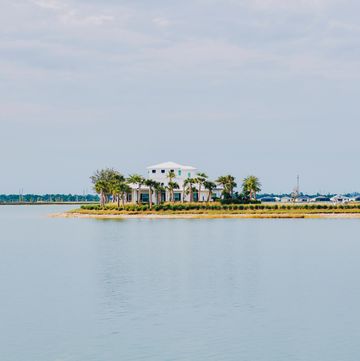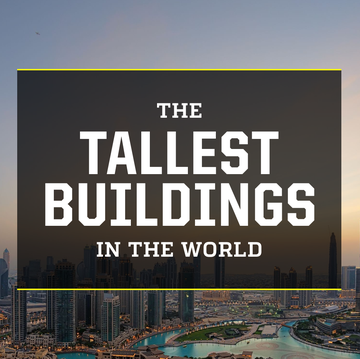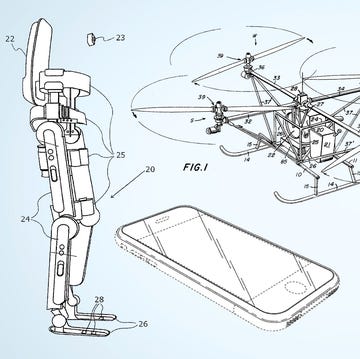1. Loopiest Water Slide
Cannonball Loop (aka the Looping Water Slide), Action Park
Action Park was a place of legends. A spectacular orgy of thrills and danger that, due to pesky things such as insurance companies and basic common sense, will likely never be recreated.
The park, which was open from 1978 to 1996, was loaded with rides that seemed intent on pushing the limits of physics. At least six people died at the hands of the parks attractions, and countless more were injured (earning the park the affectionate nicknames "Accident Park," "Traction Park" and "Class-Action Park"). But nothing quite symbolized the park's flirtation with danger like the Cannonball Loop--a ride that is better known simply as the Looping Water Slide.
We first came face to face with the monstrous tubular blue circle as children visiting the park in the late 1980s. The loop wasn't open to the public at that point, but we distinctly remember park employees taking turns on the inertia-driven ride. In fact, in the years that it stood taunting the park's thrill seekers, it was barely open to the public at all. But its imposing presence earned it countless unverified rumors: As a child, we heard that they had to close it because some kid got stuck at the top, that crash test dummies they sent down the ride came out dismembered and that the park staff were given cash to act as human guinea pigs. As adults, we were unable to verify these rumors, but many are repeated on Wikipedia.
And then there's the fact that the ride's radical design seems to betray a lack of an understanding of basic physics. To wit: The ride runs through a perfect circle. Early-roller coaster engineers toyed with this design, with disastrous results. The high g-forces that are exerted when entering and exiting the inversion of a perfect circular loop are enough to break a person's neck (this is why all roller-coaster loops are elliptical or corkscrew-shaped). If the slide's few passengers were injured, this could partly have been to blame.
Action Park closed in 1996 and with it, the Cannonball Loop was dismantled. Since then, at least one other looping water slide has popped up, this time, in Germany. From the looks of it, it's far more professional, with elliptical-shaped loops.
[youtube]http://www.youtube.com/v/2SxhNai4Zhs&hl=en&fs=1&[/youtube]
2. Most Dangerous Human Trebuchet
Human Catapult, Middlemoor Water Park, United Kingdom
Some rides are just a bad idea. Case in point: the human trebuchet at Middlemoor Water Park in the U.K. For £40 ($66) a pop, riders could crawl into the cradle of a massive medieval-style catapult and be flung at 60 mph through the air into a net positioned 75 feet away.
While previous riders suffered injuries such as a broken pelvis, the catapult ultimately proved how dangerous it could be in 2002 when 19-year-old Oxford student Dino Yankov took his turn. His launch missed the landing net, and he was killed.
[youtube]http://www.youtube.com/v/mo_oigyFlTA&hl=en&fs=1&[/youtube]
3. Scariest Zero Gravity Experience
Kingda Ka, Six Flags Great Adventure
There's something wonderful about the simplicity of Kingda Ka--a roller coaster that is about as close a ride as exists to a NASA simulator. It has no lame shtick, no fancy loops; just one short burst of track that goes up and down. The goal: Move the riders as fast and high as it possibly can. And this it does. As the tallest and fastest roller coaster in the world, Kingda Ka launches its passengers up to 128 mph in just 3.5 seconds, speeding them through the 456-foot-high track in just 28 seconds. It's basically a vomit comet --and actually renders riders weightless for a stretch.
On a recent test ride, PM staffers reported that although they lost control of their facial muscles, the ride was perhaps the most thrilling they had ever experienced. Sadly, would-be riders will have to wait: The coaster is currently closed due to mechanical issues that arose after a recent lightning strike.
[youtube]http://www.youtube.com/v/HN8nv4tVFuA&hl=en&fs=1&[/youtube]
4. Biggest Leap-of-Faith for Early Adopters
Original Ferris Wheel, 1893 World's Columbian Exposition, Chicago
Today, Ferris wheels are far from the most fearsome rides on the boardwalk. But when the first Ferris wheel was built, it was a novelty that likely struck fear into the hearts of anybody who considered riding it.
The original Ferris wheel, created for the 1893 Chicago World's Fair, was to be a symbol of the Windy City's progress. It was constructed to be a towering landmark that would "out-Eiffel the Eiffel Tower" (the French tower had been constructed for the Paris World's Fair a few years prior).
The first Ferris wheel was enormous: 284 feet tall, with 36 cars capable of holding 60 people a piece (for a total load of 2400 riders). A single revolution took 10 minutes, and 50 cents earned people two trips around the circle. But its maiden riders were undoubtedly taking a risk on a piece of unproven machinery: Before it was turned on for the first time, nobody knew if it would actually work, or would simply collapse into a pile of steel. According to Erik Larson's book on the Chicago World's Fair Devil in the White City, when the wheel first creaked into motion, onlookers saw it rain rusty bolts from above. But, fortunately, nobody was injured, and Ferris Wheels are now common theme-park and carnival attractions.
5. Most Likely To Leave Riders Black and Blue
Alpine Slide, Action Park
A blurry shot of a man hurtling down the Alpine Slide, captured from an Action Park TV commercial that aired in 1983.
If there were ever a park that deserves two spots on our list, it is Action Park (see No. 1 on the list). The park's alpine slide was certainly one of the park's most notorious rides--second only to the Looping Water Slide. For this ride, passengers hopped into single-person sleds (they were essentially modified snow sleds) and zoomed down a steep concrete-and-fiberglass track. Yes, it was fun, but it was also truly terrifying.
The ride began at the top of a hill. To get there, riders had to take a ski lift to the top. This lift went directly over the Alpine Slide's track, allowing passengers to watch riders zoom down the track below. It also afforded them a fair warning: We remember the sides of the track being littered with the sleds of accidents past. Ski-lift riders were also known to taunt--and even spit on--riders below. The hill was also heavily populated with enormous high-voltage power towers.
Because Action Park was, at its core, a water park, riders often zoomed down the Alpine Slides in swimsuits with a lot of skin exposed. When coupled with the concrete and fiberglass tracks, this made even the most minor spills dangerous skin-grating occasions. Unfortunately, these accidents were far too common. The sleds themselves were notoriously difficult to control, particularly at high speed. The only way to control the speed was to pull the brake, which slowed you down by shoving a friction-creating stick into the track below. Problem was, it didn't work very well. It took several seconds to slow down and stop, and it was far too easy to end up going far too fast. And if you decided to crawl across the track at a snail's pace, you were likely to be hit by the speed-happy passenger behind you.
In 1980, a park employee died after suffering a head injury when his sled jumped the track. The ride was reportedly responsible for more than a dozen fractures and two dozen head injuries in the years 1984 and 1985 alone.











